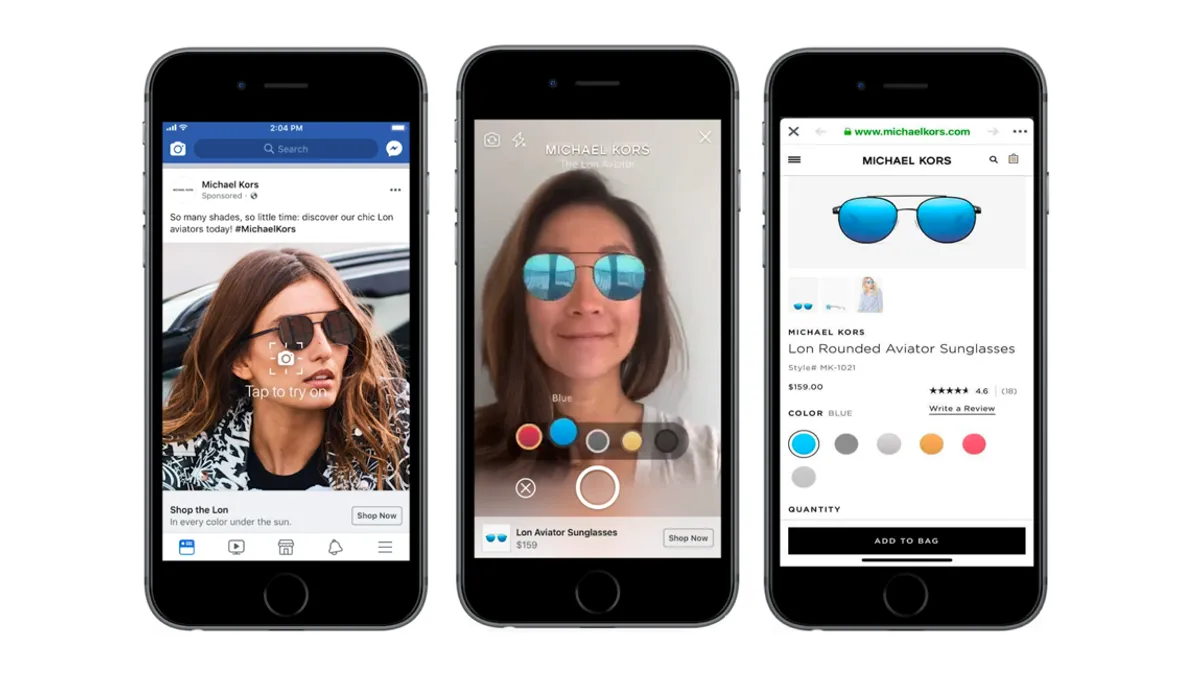Highlights
The rundown:
Became the first brand to test out AR ads in Facebook's news feed, beating out major brands like Sephora and Pottery Barn that soon followed suit.
Projected global AR ad market by 2022:
$2.6 billion
Outlook:
While AR ads are still in their infancy, Michael Kors' move is a strong indicator that the tactic can pull in big brands looking to reach mobile users at scale.
Augmented reality (AR) isn't just the future of marketing — it's the present. In 2018, brands, advertisers and platforms rushed to get in on the fast-growing market, developing new applications of the cutting edge technology to engage with and sell products to consumers.
But soon, AR will move beyond experiences or commerce into a dominant form of advertising. AR advertising is projected to grow from $167 million in 2017 to $2.6 billion in 2022, according to a report by ARtillery. This growth mirrors that of mobile advertising overall, which is forecast to grow to nearly 31% of global ad expenditure by 2020, to the tune of $187 billion. And while AR ads are still in their infancy, one mobile campaign was the strongest indicator to date that the space can pull in big brands looking to reach consumers at scale.
Leading the way in AR ads was fashion brand Michael Kors, which became the first brand to test out AR ads in Facebook's Newsfeed, allowing users to virtually try-on a pair of sunglasses and make a purchase as part of the experience. The move made it first to market on the biggest mobile advertising platform, beating out fashion accessories, cosmetics, furniture, gaming and entertainment companies like Sephora, NYX Professional Makeup, Bobbi Brown, Pottery Barn and King, which began testing the ads soon after.
The sunglass overlay in the Kors ad was a simple AR application. Beyond try-ons, AR ads could take the form of sponsored virtual "portals" like the ones offered by Coca-Cola's NASCAR integration and Snapchat's forthcoming original programming. As AR becomes a richer format, so will AR ads.
While the results of the Michael Kors campaign are unknown, other AR ads, like Saban's 25th anniversary of "Power Rangers" campaign, produced a click-through-rate (CTR) of 2.1%, outpacing the industry benchmark of 0.08%. The high engagement of AR ads has led other platforms to experiment with the format: Verizon's Oath worked with Pottery Barn and The Home Depot while Blippar created ads Jaguar Land Rover and Honda. However, neither these platforms nor Snapchat has the massive reach of Facebook and its Newsfeed.
While Facebook had initially tested AR ads in Messenger, bringing the format to its flagship product signaled the importance that the social networking platform sees in the technology. On Messenger, a variety of brands saw successes with AR ads, with ASUS seeing 10 times the engagement with their AR experience, Nike selling out of the Kyrie 4s shoe in under an hour and Kia increasing engagement with its dealers.
Monthly AR users in U.S. (2018)
Source: The Boston Consulting GroupFor Facebook, AR ads present an opportunity for the platform to hold onto its 20% share of the U.S. digital ad market despite increasing competition by Amazon and innovation by Snap. With the latter, Facebook has been savvy enough to integrate Snap's features to undercut the struggling social messaging platform. Following its adoption of Stories in both Facebook and Instagram, the company rolled out AR, a technology that Snapchat continues to experiment and innovate with.
While Snapchat is often the first to bring these AR experiences to market, Facebook is often the company that sees the fruits of Snap's labor, and will continue to do so if big brands choose its platforms — Newsfeed, Messenger, Instagram — for their AR ad campaigns. For brands adopting AR ads, the future is now.
Read More
-
Facebook opens Stories ads to all advertisers
By Chris Kelly • Sept. 26, 2018 -
Facebook brings playable ads to the news feed
By Robert Williams • Aug. 3, 2018
















